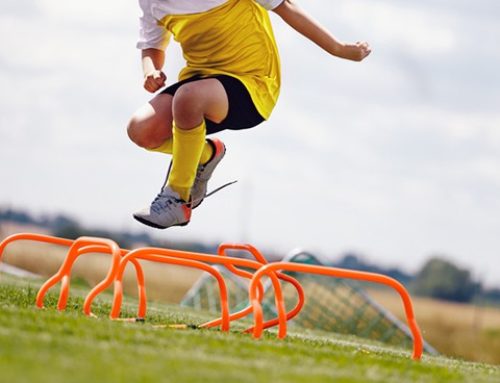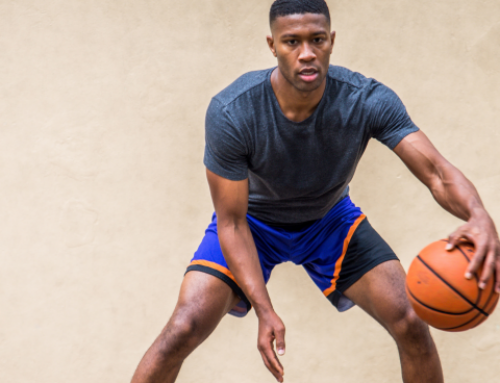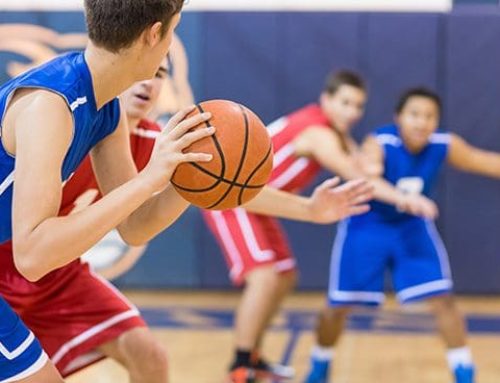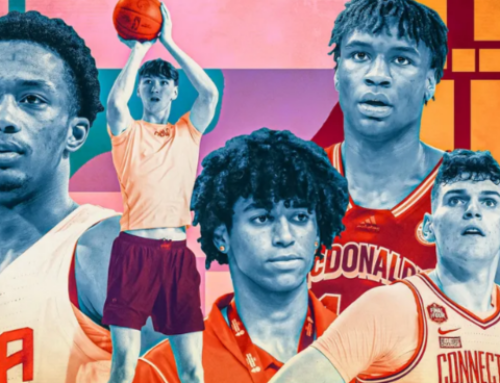Speed Training with the San Antonio Spurs
In case you blinked during the NBA Finals last season, here are some highlights of what you missed: A Tony Parker dash through the lane with a perfect finish. A 27-point lead in the fourth quarter of Game 2. A swift sweep of a young LeBron-led contender from the East.
It’s official. The San Antonio Spurs are a full-on hoops dynasty. Even the team’s harshest critics can’t deny the Spurs’ complete dominance during their four NBA Championship runs in eight years. And no way did it result from lack of competition; the Spurs have had to battle perennial powerhouses in the West, like the Suns and Mavs, throughout the playoffs, then take on the bruising Pistons and upstart Cavaliers in the Finals.
Undoubtedly, experience and money shooting have helped the Spurs become the best in the world. But what has kept them untouchable is their court movement throughout games. “Speed is of the essence in separating yourself in this league,” says long-time team strength and conditioning coach Mike Brungardt. “There is constant movement in this game; that’s why people love it. We’ve focused on developing movement, and it has been a huge part of our championship runs. Great movement has allowed us to compete with fast teams like Phoenix and wreak havoc on half-court-oriented teams, because they can’t keep up with us.”
Both their speedy guards and smooth-moving post men create chaos for Spurs’ opposition. “We’ve got Tony Parker, Manu Ginobli and Bruce Bowen, all of whom have some of the best movement in the league,” Brungardt says. “On top of that, our big men can run the court as well as anyone. Once we got Tony and the other guys, we made it our philosophy to push the pace as much as possible.”
A rapid pace for a starting five is useless without the ability to sustain it, so Brungardt’s mission is to build a fast that lasts. “Our goal is to be as quick at the end of a game as we are at the start, and our past performances show that we are,” he says. “We have been exceptional in the last five minutes of games. And that’s what determines a championship win.”
Brungardt uses a four-part off-season approach: speed ladder work, hill training, various hops and weighted movements. The blending and strategic timing of these components result in faster, quicker, stronger and fitter athletes—a lethal combination for NBA players.
One Spur who has been more lethal than most is 2007 Finals MVP Tony Parker. But Parker wasn’t always perfectly tailored for the game. “When Tony came into the league, he couldn’t even bench the bar,” Brungardt recalls. “The bench is no indicator of what kind of basketball player you are, but his overall strength was very low—so improving it was critically important. In his first year, he couldn’t finish at the rim; and now he probably finishes better than anyone.”
Check out Brungardt’s World Champion speed training, and take the first step toward building a dynasty of your own.
Speed Ladder
Almost every sports team uses the Speed Ladder, but Brungardt does things a little differently—and better—than most. First, the Spurs perform all of these drills with “defensive hands”—hands up and fingers spread. Second, Brungardt intersperses ladder work with other training at different times for different results.
The Spurs hit the ladder quick and hard to warm up for weightlifting sessions. Midway through the lift, they hit it again, then once more at the end. “From a neuromuscular standpoint, there is a recruitment that happens when your muscles are a little fatigued and warmed up,” Brungardt says. “So the fatigue midway through the lift and at the end allows us to get some results that we otherwise couldn’t get—one being the ability to stay quick when we’re tired.”
Check out Brungardt’s favorite ladder drills. Mix them with some other familiar patterns before, during and after your lifts to gain Spurs-like foot skills.
Lateral One Foot in Each
Shuffle laterally, placing one foot in each box so both feet are never in the same box at the same time. Repeat in opposite direction
Ickey Shuffle
Facing ladder, shuffle diagonally through each square with a two-feet-in, one-foot-out pattern. Repeat backwards
Ickey Shuffle Load
Perform Ickey Shuffle, but each time you step out with your right foot, take a wide step. Land with knee bent and hold “loaded” position for one count. Shuffle back quickly; continue pattern—quick on left, wide on right—down ladder. Repeat with “loaded” step on left and quick shuffle on right
Lateral W
Shuffle laterally down length of ladder in W pattern by placing two feet in and two feet out. Repeat in opposite direction
Crossover
Begin at side of ladder and cross outside foot over and into box. Rotate hips, then step both feet out. Continue crossing over with outside foot and performing one-in, two-out pattern down length of ladder. Repeat backwards
Crossover Load
Perform Crossover with “loaded” step on right side. Repeat with “loaded” step on left side (see Ickey Shuffle Load)
Sets/Reps:
As Warm-up: 2×6-8 foot skills
During Lift: 2×2-4 foot skills
After Lift: 2×2-4 foot skills
Brungardt: When you begin a new ladder pattern, go through it slowly until you can do it right, or else you’ll end up all over the place. Only pick up your speed once you know it. Once you know the drill, perform it as quickly as possible. Imagine the ground is a bed of hot coals, so you touch and get off as quickly as you can. The “Load” variations work speed and strength, because they incorporate a lateral lunge movement.
The Hill
Behind the Spurs training facility is a 45-degree, 40-yard-long man-made hill. The players tackle the hill, in virtually every direction, twice a week in the off-season. Find a similar incline and perform the following drills to the top. Walk down slowly, then hit it again.
Forward Sprint
Backward Run
Lateral Slide [R & L]
Power Skip
Standing Broad Jumps
Speed Skaters—Bound continuously from right foot to left foot at 45-degree angles
Triple Jump—In continuous fashion, jump off both feet, then one foot and then the other
Loaded Run—Get a 15-yard running start, then sprint up hill
Reps/Sets:
After a heavy leg lift: 1×1 each variation
After a light leg lift: 3×3-5 each variation
Brungardt: A huge goal in basketball is to convert the strength you gain in the weight room to power. The hill is a great way to transfer that strength into actual motion, because getting up the hill requires strength—and we’re sprinting. This is also better than running stadiums, because the hill gives you a natural foot plant that loads both muscles of the calf, which are prime jumping muscles. With stadiums, you have a flat foot plant on each step.
Weighted Jumps and Movement
Med Ball Quick Jump
- Holding med ball, assume athletic stance underneath rim
- Explode up and touch med ball to rim
- Immediately upon landing, jump and touch med ball to rim again
- Immediately upon landing, jump and dunk the ball
- Repeat for specified reps
- Perform last set with basketball
Variation: Lay ball in if you can’t dunk
Sets/Reps: 3-5 sets x 3-5 reps. (Two rim touches and a dunk constitutes one rep)
Brungardt: This promotes quick second and third jumps, which are extremely important when you’re trying to go back up with the ball or block a shot.
Weighted Drop Step
- Wearing weighted vest, assume athletic stance at block
- Receive ball from partner, perform drop step and dunk ball
- Immediately sprint to opposite block and set up facing second partner
- Receive ball from partner, drop step and dunk ball
- Keep moving between blocks and dunking for specified reps and sets
- Perform last set without weighted vest
Variation: Lay ball in if you are unable to dunk. Use med ball if weight vest is unavailable
Sets/Reps: 3×3 dunks on each block
Brungardt: In addition to the vertical element, the back-and-forth between blocks requires a certain amount of lateral movement. We incorporate this drill into our lifting sessions, when we’re fatigued, to recruit fibers we haven’t used. We perform the first set after our warm-up and then perform the next set after we’ve done a few lifts.
Quick Sticks
Place two pieces of tape on the ground to form a large cross. Perform the following patterns on the cross with both legs, with just your right leg, then with just your left leg.
Side-to-Side Hops
Front-to-Back Hops
Triangle Hops [Right] —forward, right, diagonal back and left
Triangle Hops [Left] —forward, left, diagonal back and right
Sets/Reps: 1×20 each variation
Bungardt: We especially like the single-leg hops because they require a lot of strength that is very important to basketball movement.
RECOMMENDED FOR YOU
MOST POPULAR
Speed Training with the San Antonio Spurs
In case you blinked during the NBA Finals last season, here are some highlights of what you missed: A Tony Parker dash through the lane with a perfect finish. A 27-point lead in the fourth quarter of Game 2. A swift sweep of a young LeBron-led contender from the East.
It’s official. The San Antonio Spurs are a full-on hoops dynasty. Even the team’s harshest critics can’t deny the Spurs’ complete dominance during their four NBA Championship runs in eight years. And no way did it result from lack of competition; the Spurs have had to battle perennial powerhouses in the West, like the Suns and Mavs, throughout the playoffs, then take on the bruising Pistons and upstart Cavaliers in the Finals.
Undoubtedly, experience and money shooting have helped the Spurs become the best in the world. But what has kept them untouchable is their court movement throughout games. “Speed is of the essence in separating yourself in this league,” says long-time team strength and conditioning coach Mike Brungardt. “There is constant movement in this game; that’s why people love it. We’ve focused on developing movement, and it has been a huge part of our championship runs. Great movement has allowed us to compete with fast teams like Phoenix and wreak havoc on half-court-oriented teams, because they can’t keep up with us.”
Both their speedy guards and smooth-moving post men create chaos for Spurs’ opposition. “We’ve got Tony Parker, Manu Ginobli and Bruce Bowen, all of whom have some of the best movement in the league,” Brungardt says. “On top of that, our big men can run the court as well as anyone. Once we got Tony and the other guys, we made it our philosophy to push the pace as much as possible.”
A rapid pace for a starting five is useless without the ability to sustain it, so Brungardt’s mission is to build a fast that lasts. “Our goal is to be as quick at the end of a game as we are at the start, and our past performances show that we are,” he says. “We have been exceptional in the last five minutes of games. And that’s what determines a championship win.”
Brungardt uses a four-part off-season approach: speed ladder work, hill training, various hops and weighted movements. The blending and strategic timing of these components result in faster, quicker, stronger and fitter athletes—a lethal combination for NBA players.
One Spur who has been more lethal than most is 2007 Finals MVP Tony Parker. But Parker wasn’t always perfectly tailored for the game. “When Tony came into the league, he couldn’t even bench the bar,” Brungardt recalls. “The bench is no indicator of what kind of basketball player you are, but his overall strength was very low—so improving it was critically important. In his first year, he couldn’t finish at the rim; and now he probably finishes better than anyone.”
Check out Brungardt’s World Champion speed training, and take the first step toward building a dynasty of your own.
Speed Ladder
Almost every sports team uses the Speed Ladder, but Brungardt does things a little differently—and better—than most. First, the Spurs perform all of these drills with “defensive hands”—hands up and fingers spread. Second, Brungardt intersperses ladder work with other training at different times for different results.
The Spurs hit the ladder quick and hard to warm up for weightlifting sessions. Midway through the lift, they hit it again, then once more at the end. “From a neuromuscular standpoint, there is a recruitment that happens when your muscles are a little fatigued and warmed up,” Brungardt says. “So the fatigue midway through the lift and at the end allows us to get some results that we otherwise couldn’t get—one being the ability to stay quick when we’re tired.”
Check out Brungardt’s favorite ladder drills. Mix them with some other familiar patterns before, during and after your lifts to gain Spurs-like foot skills.
Lateral One Foot in Each
Shuffle laterally, placing one foot in each box so both feet are never in the same box at the same time. Repeat in opposite direction
Ickey Shuffle
Facing ladder, shuffle diagonally through each square with a two-feet-in, one-foot-out pattern. Repeat backwards
Ickey Shuffle Load
Perform Ickey Shuffle, but each time you step out with your right foot, take a wide step. Land with knee bent and hold “loaded” position for one count. Shuffle back quickly; continue pattern—quick on left, wide on right—down ladder. Repeat with “loaded” step on left and quick shuffle on right
Lateral W
Shuffle laterally down length of ladder in W pattern by placing two feet in and two feet out. Repeat in opposite direction
Crossover
Begin at side of ladder and cross outside foot over and into box. Rotate hips, then step both feet out. Continue crossing over with outside foot and performing one-in, two-out pattern down length of ladder. Repeat backwards
Crossover Load
Perform Crossover with “loaded” step on right side. Repeat with “loaded” step on left side (see Ickey Shuffle Load)
Sets/Reps:
As Warm-up: 2×6-8 foot skills
During Lift: 2×2-4 foot skills
After Lift: 2×2-4 foot skills
Brungardt: When you begin a new ladder pattern, go through it slowly until you can do it right, or else you’ll end up all over the place. Only pick up your speed once you know it. Once you know the drill, perform it as quickly as possible. Imagine the ground is a bed of hot coals, so you touch and get off as quickly as you can. The “Load” variations work speed and strength, because they incorporate a lateral lunge movement.
The Hill
Behind the Spurs training facility is a 45-degree, 40-yard-long man-made hill. The players tackle the hill, in virtually every direction, twice a week in the off-season. Find a similar incline and perform the following drills to the top. Walk down slowly, then hit it again.
Forward Sprint
Backward Run
Lateral Slide [R & L]
Power Skip
Standing Broad Jumps
Speed Skaters—Bound continuously from right foot to left foot at 45-degree angles
Triple Jump—In continuous fashion, jump off both feet, then one foot and then the other
Loaded Run—Get a 15-yard running start, then sprint up hill
Reps/Sets:
After a heavy leg lift: 1×1 each variation
After a light leg lift: 3×3-5 each variation
Brungardt: A huge goal in basketball is to convert the strength you gain in the weight room to power. The hill is a great way to transfer that strength into actual motion, because getting up the hill requires strength—and we’re sprinting. This is also better than running stadiums, because the hill gives you a natural foot plant that loads both muscles of the calf, which are prime jumping muscles. With stadiums, you have a flat foot plant on each step.
Weighted Jumps and Movement
Med Ball Quick Jump
- Holding med ball, assume athletic stance underneath rim
- Explode up and touch med ball to rim
- Immediately upon landing, jump and touch med ball to rim again
- Immediately upon landing, jump and dunk the ball
- Repeat for specified reps
- Perform last set with basketball
Variation: Lay ball in if you can’t dunk
Sets/Reps: 3-5 sets x 3-5 reps. (Two rim touches and a dunk constitutes one rep)
Brungardt: This promotes quick second and third jumps, which are extremely important when you’re trying to go back up with the ball or block a shot.
Weighted Drop Step
- Wearing weighted vest, assume athletic stance at block
- Receive ball from partner, perform drop step and dunk ball
- Immediately sprint to opposite block and set up facing second partner
- Receive ball from partner, drop step and dunk ball
- Keep moving between blocks and dunking for specified reps and sets
- Perform last set without weighted vest
Variation: Lay ball in if you are unable to dunk. Use med ball if weight vest is unavailable
Sets/Reps: 3×3 dunks on each block
Brungardt: In addition to the vertical element, the back-and-forth between blocks requires a certain amount of lateral movement. We incorporate this drill into our lifting sessions, when we’re fatigued, to recruit fibers we haven’t used. We perform the first set after our warm-up and then perform the next set after we’ve done a few lifts.
Quick Sticks
Place two pieces of tape on the ground to form a large cross. Perform the following patterns on the cross with both legs, with just your right leg, then with just your left leg.
Side-to-Side Hops
Front-to-Back Hops
Triangle Hops [Right] —forward, right, diagonal back and left
Triangle Hops [Left] —forward, left, diagonal back and right
Sets/Reps: 1×20 each variation
Bungardt: We especially like the single-leg hops because they require a lot of strength that is very important to basketball movement.










